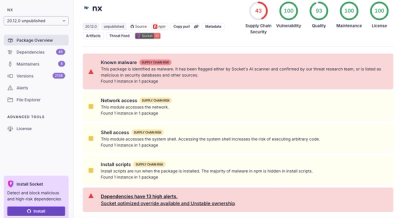
Security News
/Research
Wallet-Draining npm Package Impersonates Nodemailer to Hijack Crypto Transactions
Malicious npm package impersonates Nodemailer and drains wallets by hijacking crypto transactions across multiple blockchains.
placeholderify
Advanced tools
A CSS library to make real HTML elements look like placeholders to simplify making placeholders of elements when the data is loading or reloading.
A pure CSS library that automatically transforms real HTML elements into placeholders to simplify loading states, without requiring any JavaScript or efforts from your side.
The classic approach requires designing separate HTML code for placeholders when a component is in a loading state. However, this means you have to manage and sync two versions of the element: the real one and its placeholder representation.
This CSS library allows you to manage only one version of an HTML component - the real HTML code. The library automatically converts the design of the real HTML elements into a placeholder style.
All you have to do is apply the placeholderify CSS class to the root HTML
element of your component, and all child elements will be converted into
placeholders automatically.
Let's imagine that you have a Bootstrap Card like this:
<div class="card">
<img src="https://picsum.photos/600/400" class="card-img-top" alt="My image">
<div class="card-body">
<h5 class="card-title">Card title</h5>
<p class="card-text">Some quick example text to build on the card title and make up the bulk of the card's content.</p>
<a href="#" class="btn btn-primary">Go somewhere</a>
</div>
</div>
And to make a placeholder from it, you should just add a CSS library and the
placeholdify class to the component:
<link rel="stylesheet" media="all" href="//murznn.github.io/placeholderify/dist/placeholderify.min.css" />
<div class="card placeholderify" >
<img src="https://picsum.photos/600/400" class="card-img-top" alt="My image">
<div class="card-body">
<h5 class="card-title">Card title</h5>
<p class="card-text">Some quick example text to build on the card title and make up the bulk of the card's content.</p>
<a href="#" class="btn btn-primary">Go somewhere</a>
</div>
</div>
And that's it! 😎 No code duplication and no separate templates for placeholders!
To restore the real component, simply remove the placeholderify class.
Also, the library provides a placeholder for reloading element, when you don't
need to hide the current content, for that cases include the reloadify.css
file and use the reloadify class.
For a live demonstration and customization options, check out the example HTML file.
The library provides several separate CSS files with different approaches:
placeholderify.min.css and placeholderify class: a default approach which
replaces everything inside the element by squares. And the shortened version:
phfy.min.css and phfy class.
reloadify.min.css and reloadify class: an approach for reloading elements
with actual content. Do not hides the texts, just adds a cover and animation.
And the shortened version: rlfy.min.css and rlfy class.
placeholderify-img.min.css and placeholderify-img class: the same as
placeholderify but keeps the images visible. And the shortened version:
phfyi.min.css and phfyi class.
placeholderify-lines.min.css and placeholderify-lines class: coverts only
inline elements to blocks. And the shortened version: phfyl.min.css and
phfyl class.
The library supports customization through CSS variables. Here are the available options:
--placeholderify-opacity: Controls the opacity of placeholder elements
(default: 0.33)--placeholderify-background-color: Sets the background color for text
elements and images (default: currentcolor for text, black for images)--placeholderify-cover-background: Defines the gradient used for the glow
effect (default: linear gradient from transparent to semi-transparent white)--placeholderify-cover-animation-name: The name of the animation for the
glow effect (default: placeholderify-animation)--placeholderify-cover-animation-duration: Duration of the glow animation
(default: 0.5s)--placeholderify-cover-animation-timing-function: Timing function for the
glow animation (default: linear)Usage Example:
.my-custom-placeholder {
--placeholderify-opacity: 0.5;
--placeholderify-background-color: #e0e0e0;
--placeholderify-cover-animation-duration: 1s;
}
To exclude specific elements from being transformed into placeholders, add the
placeholderify-ignore class to them.
In some cases you probably want to keep images visible in the placeholders. To
keep only specific images visible, use the placeholderify-ignore class. To
make all images visible - use the placeholderify-img.css file and the
placeholderify-img class. See example HTML file with keeping
images.
To make your HTML code more compact, the library provides shorten versions of classes in the correspoindig CSS files:
placeholderify » phfyreloadify » rlfyplaceholderify-img » phfyiplaceholderify-lines » phfylFAQs
A CSS library to make real HTML elements look like placeholders to simplify making placeholders of elements when the data is loading or reloading.
We found that placeholderify demonstrated a healthy version release cadence and project activity because the last version was released less than a year ago. It has 1 open source maintainer collaborating on the project.
Did you know?

Socket for GitHub automatically highlights issues in each pull request and monitors the health of all your open source dependencies. Discover the contents of your packages and block harmful activity before you install or update your dependencies.

Security News
/Research
Malicious npm package impersonates Nodemailer and drains wallets by hijacking crypto transactions across multiple blockchains.

Security News
This episode explores the hard problem of reachability analysis, from static analysis limits to handling dynamic languages and massive dependency trees.

Security News
/Research
Malicious Nx npm versions stole secrets and wallet info using AI CLI tools; Socket’s AI scanner detected the supply chain attack and flagged the malware.